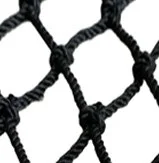Choosing a hay net to use with your HayPal hay net feeder
Hay nets are loaded directly onto HayPal feeders by manually weaving a net onto the HayPal frame. This is the most secure method of attaching a hay net to a feeder.
Types of Hay Nets
There are 2 basic types of hay nets: knotless or knotted.
As there is not much research available on the topic (see article linked below), it is primarily a personal preference. After trying many of the available types of nets on the market, HayPal has determined to offer polyester nets in the knotless format.
Some people feel there is the potential for damage (cuts, dental issues, etc) with the knotted nets, but do not have any first- or second-hand knowledge of these concerns. If you have a very tough horse, you may find that the heavy-duty knotted nets last longer.
Hay Net Hole Size
Perhaps the more important choice is the size of holes in the hay net. Bigger holes equal faster eating; smaller holes, slower eating. Not all horses will tolerate the smallest hole (1”).
If you’re unsure of which hole size to choose, try a 1.5” hole net (sometimes offered as 1.75”).
Some nets are as large as 4” holes, and are primarily designed for easy access that keeps most of the hay off the ground.
Loading a hay net onto a HayPal feeder
Visit our instructional guides to find out how to load a hay net onto your HayPal. Most of our feeders have snap buttons that open up and allow the hay net to be woven onto the aluminum frame.
IMPORTANT SAFETY NOTE: Prior to mounting the hay net feeder onto a wall or fence, hold the feeder (with a net pre-loaded) in your desired location and check to ensure that the bottom of the empty net rests at least 6” off the ground. Please note that hay nets are not recommended for use with shod horses.
If your empty net does not sit 6” off the ground, adjust either the location of the feeder or, more typically, the length of the net. To adjust the length of the net, either shorten it by adjusting the closure at the bottom of the bag (for example, many bags use a carabiner to secure the bottom of the net; simply adjust the length of the net by moving the carabiner), or, if the bottom is not adjustable, re-load the hay net onto feeder further into the net (ie: instead of weaving the net onto the top loop, weave the net onto a loop of the net that is a few inches down).


